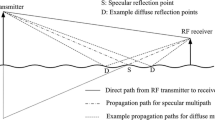Abstract
The effects of surface and atmospheric mechanisms involved in the generation of frequency-selective multipath fading have to be investigated to help improve the performance of wide-band digital radio systems on line-of-sight microwave links. In this paper, three typical mechanisms of super-refractive layer formation are simulated: a layer which develops and grows close to the ground level (ground-based layer), a layer which forms close to the ground and then weakens in elevating (rising or elevating layer), and a layer which appears above the antenna heights and grows at this altitude (elevated layer). A ray-tracing program is then used to compute the time response of the propagation channel for each of these three layers. The results are compared with experimental observations and space diversity considerations are also presented.
Résumé
Les effets des mécanismes atmosphériques et de surface conduisant à la présence de trajets multiples, et donc à des affaiblissements sélectifs en fréquence, doivent être étudiés pour améliorer les performances des systèmes numériques à large bande sur faisceaux hertziens hyperfréquences en visibilité. Dans cet article, trois mécanismes typiques conduisant à supraréfraction sont simulés: une couche qui se développe et grandit au niveau du sol (couche basée au sol), une couche qui se forme près du sol et s’affaiblit en prenant de ľaltitude (couche montante), et une couche qui apparaît au-dessus des hauteurs ďantenne et grandit à cette altitude (couche élevée). Un programme de tracé de rayons est ensuite utilisé pour calculer la réponse temporelle du canal de propagation pour chacune de ces trois couches. Les résultats sont comparés avec des observations expérimentales, et des considérations sur ľutilisation ďune technique par diversité ďespace sont aussi présentées.
Similar content being viewed by others
References
Beckmann (P.),Spizzichino (A.). The scattering of electromagnetic waves from rough surfaces.Pergamon, New York (1963).
Blanchetiere-Ciarletti (V.), Lavergnat (J.), Sylvain (M), Weill (A.). Experimental observation of horizontal refractivity gradients during periods of multipath propagation.Radio Sci. (1989),24, n° 6, pp. 705–724.
Brutsaert (W. H.). Evaporation into the atmosphere: theory, history, and applications.D. Reidel Publishing Company, Dordrecht, Boston, London (1982), p. 114.
Costa (E.). The effects of ground reflected rays and atmospheric inhomogeneities on multipath fading.IEEE Trans. AP (1991),39, n° 6, pp. 740–745.
Giger (A. J.),Alley (G. D.),Sullivan (P. L.),Major (D. E.). Time and frequency fluctuations of microwave interference due to terrain scatter.IEEE Global Telecom. Conf. (1986), pp. 4.3.5.1–4.3.5.7.
Gossard (E. E.), Neff (W. D.), Zamora (R. J.), Gaynor (J. E.). The fine structure of elevated layers: implications for over-the-horizon propagation and radar sounding systems.Radio Sci. (1984),19, n° 6, pp. 1523–1533.
Ikegami (F.), Haga (M.), Fuguda (T.), Yoshida (H.). Experimental studies on atmospheric ducts and microwave fading.Rev. Electr. Comm. Lab. (1966),14, pp. 505–533.
Rana (D.), Webster (A. R.), Sylvain (M.). Statistical characterization of line-of-sight microwave links.Radio Sci. (1992),27, n° 6, pp. 783–796.
Valentin (R.),Giloi (H.-G.),Metzger (K.). On the characterization of Los propagation channels with frequency-selective fading.URSI Commission F Symposium (1992), pp. 9.2.1–9.2.5.
Webster (A. R.). Ray path parameters in tropospheric multipath propagation.IEEE Trans. AP (1982),30, n° 4, pp. 796–800.
Webster (A. R.). Angles-of-arrival and delay times on a terrestrial line-of-sight microwave links.IEEE Trans. AP (1983),31, n° 1, pp. 12–17.
Webster (A. R.), Merritt (T. S.). Multipath angles-of-arrival on a terrestrial microwave link.IEEE Trans. Commun. (1990),38, n° 1, pp. 25–30.
Webster (A. R.). Rough elevated layers and tropospheric microwave propagation.Antennas Propag. Society Symposium (1991a), pp. 1552–1553.
Webster (A. R.). Multipath angle-of-arrival measurements on microwave line-of-sight links.IEEE Trans. AP (1991b),39, n° 6, pp. 798-803.
Webster (A. R.). Some experimental results relating to diversity systems on line-of-sight microwave links.North American Radio Science Meeting (1991c), p. 447.
Webster (A. R.),Rana (D.),Jones (J.). Distributions in angleof-arrival and amplitude of multipath components on a microwave line-of-sight link.URSI Commission F Symposium (1992), p. 9.4.1–9.4.5.
Author information
Authors and Affiliations
Rights and permissions
About this article
Cite this article
Rana, D., Webster, A.R. & Sylvain, M. Origin of multipath fading on a terrestrial microwave link. Ann. Télécommun. 48, 557–566 (1993). https://doi.org/10.1007/BF02995491
Received:
Accepted:
Issue Date:
DOI: https://doi.org/10.1007/BF02995491
Key words
- Multipath propagation
- Selective fading
- Radio relay link
- Line of sight propagation
- Atmospheric refraction
- Ground effect
- Space diversity




